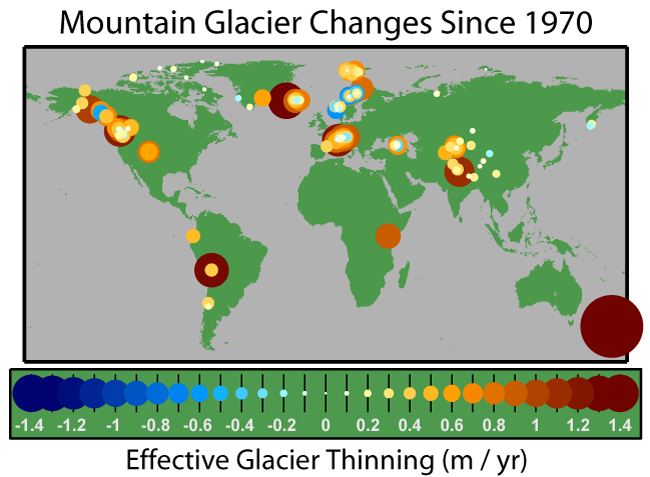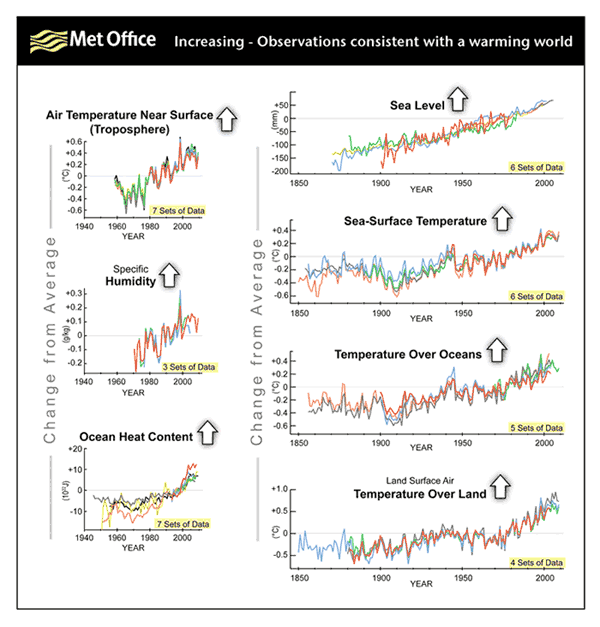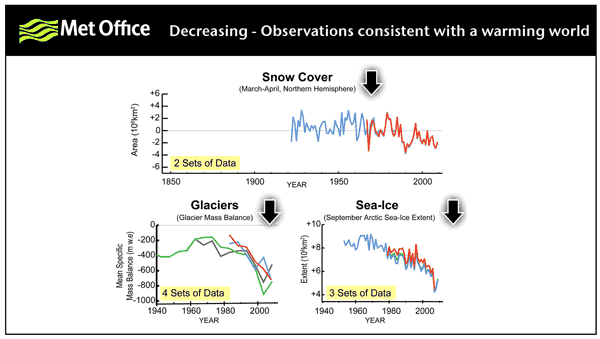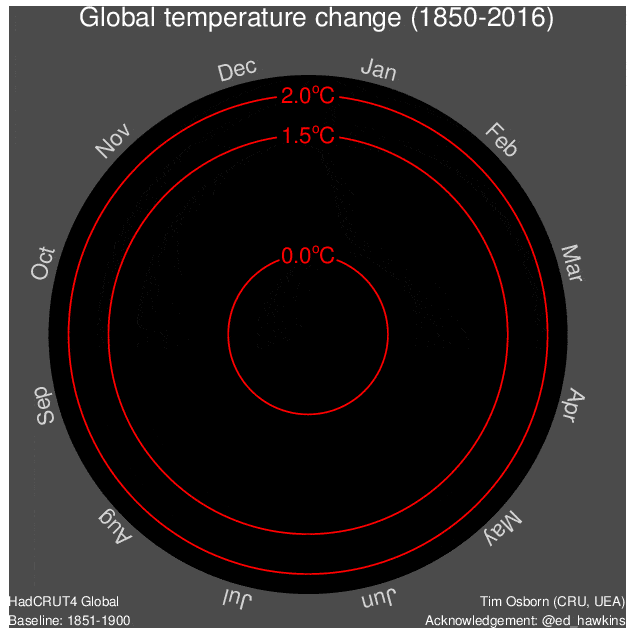Po želji. Evo dela Američkog zvaničnog izveštaja o klimi, o zagrevanju Arktika. Ukratko, ne samo da se zagreva, nego se zagreva dva puta brže od globalnog rasta temparatura. U originalnoj verziji teksta na sajtu postoje reference sa linkovima na izvore podataka. Ako neko želi da ovo prepriča na Srpski, svaka čast. Ja jednostavno nemam ni vremena ni volje za to.
11.2.1 Alaska and Arctic Temperature
Surface temperature—an essential component of the arctic climate system—drives and signifies change, fundamentally controlling the melting of ice and snow. Further, the vertical profile of boundary layer temperature modulates the exchange of mass, energy, and momentum between the surface and atmosphere, influencing other components such as clouds. , Arctic temperatures exhibit spatial and interannual variability due to interactions and feedbacks between sea ice, snow cover, atmospheric heat transports, vegetation, clouds, water vapor, and the surface energy budget. , , Interannual variations in Alaskan temperatures are strongly influenced by decadal variability like the Pacific Decadal Oscillation (Ch. 5: Circulation and Variability). ,
However, observed temperature trends exceed this variability.
Arctic surface and atmospheric temperatures have substantially increased in the observational record.
Multiple observation sources, including land-based surface stations since at least 1950 and available meteorological reanalysis datasets, provide evidence that arctic near-surface air temperatures have increased more than twice as fast as the global average. , , , , Showing enhanced arctic warming since 1981, satellite-observed arctic average surface skin temperatures have increased by 1.08° ± 0.13°F (+0.60° ± 0.07°C) per decade. As analyzed in Chapter 6: Temperature Change (Figure 6.1), strong near-surface air temperature warming has occurred across Alaska exceeding 1.5°F (0.8°C) over the last 30 years. Especially strong warming has occurred over Alaska’s North Slope during autumn. For example, Utqiagvik’s (formally Barrow) warming since 1979 exceeds 7°F (3.8°C) in September, 12°F (6.6°C) in October, and 10°F (5.5°C) in November.
Enhanced arctic warming is a robust feature of the climate response to anthropogenic forcing. , An anthropogenic contribution to arctic and Alaskan surface temperature warming over the past 50 years is very likely. , , , , One study argues that the natural forcing has not contributed to the long-term arctic warming in a discernable way. Also, other anthropogenic forcings (mostly aerosols) have likely offset up to 60% of the high-latitude greenhouse gas warming since 1913,
suggesting that arctic warming to date would have been larger without the offsetting influence of aerosols. Other studies argue for a more significant contribution of natural variability to observed arctic temperature trends , and indicate that natural variability alone cannot explain observed warming. It is very likely that arctic surface temperatures will continue to increase faster than the global mean through the 21st century. , , ,
https://science2017.globalchange.gov/chapter/11/
----------------------------------------------------------------------------------------------------------------------------
Drugi izvor:
Arctic Report Card: Update for 2017
Arctic Essays
Surface Air Temperature
Highlights
- The average annual surface air temperature anomaly over land north of 60° N for October 2016-September 2017 was the second highest (after 2015-2016), in the observational record beginning in 1900.
- Arctic air temperature continues to increase at double the rate of the global mean air temperature increase.
- Extreme Arctic-wide air high temperatures were observed in autumn 2016 (October-December); extensive regions over the central Arctic showed anomalies exceeding +5° C. These conditions were primarily due to southerly winds moving warm air into the Arctic from the mid-latitude Pacific and Atlantic oceans.
- Neutral temperature anomalies occurred across the central Arctic Ocean with weak sea level pressure gradients. Like summer 2016, summer 2017 weather conditions did not support rapid summer sea ice and ice sheet loss.
Arctic surface air temperature is an indicator of regional and global climate change. Although there are year-to-year and regional differences in air temperatures due to natural variability, the magnitude and Arctic-wide character of the long-term temperature increase is a major indicator of global warming and the influence of increases in greenhouse gases (Overland, 2009; Notz and Stroeve, 2016). We report on the spatial and temporal variability of Arctic air temperatures during the period October 2016 through September 2017, the 12-month period since the end of the previous reporting period in Arctic Report Card 2016.
After a very warm autumn across the Arctic 2016 and a warm winter on the Asian side, spring and summer 2017 had near-average air temperatures relative to the 1981-2010 climatology. Spring and summer 2017 temperatures were reminiscent of conditions (see essay on Terrestrial Snow Cover) before the long-term temperatures increases that began in the 1990s. The impact of the 2017 spring and summer conditions is seen throughout the contributions in Arctic Report Card 2017. For instance, there was more snow in spring and less sea ice and ice sheet melt in summer. The 2017 fire season was not unusual. Unlike many recent years of the previous decade, where high sea level pressure dominated the Arctic region, weak low pressure systems were observed in spring and summer 2017. The latter is more consistent with atmospheric and wind forcing patterns typically observed prior to 2007 (Overland et al., 2017), and runs counter to the conditions driving the longer-term trends reported throughout Arctic Report Card 2017.
Mean Annual Land Surface Air Temperature
At +1.6° C, the mean annual surface air temperature (SAT) anomaly for October 2016-September 2017 for land stations north of 60° N is the second highest value (after 2016) in the record starting in 1900 (Fig. 1). Currently, the Arctic is warming at more than twice the rate of global mean temperatures (Fig. 1).
Arctic and global mean annual land surface air temperature anomalies
Fig. 1. Arctic (land stations north of 60° N) and global mean annual land surface air temperature (SAT) anomalies (in °C) for the period 1900-2017 relative to the 1981-2010 mean value. Note that there were few stations in the Arctic, particularly in northern Canada, before 1940. The data are from the CRUTEM4 dataset, which is available at
http://www.cru.uea.ac.uk/cru/data/temperature/.
The greater rate of Arctic temperature increase, compared to the global mean increase, is referred to as Arctic Amplification. Mechanisms for Arctic Amplification include: reduced summer albedo, due to sea ice and snow cover loss; the increase of total water vapor content in the Arctic atmosphere; a summer decrease and winter increase in total cloudiness (Makshtas et al., 2011; Lenaerts et al., 2017); the additional heat generated by newly sea-ice free ocean areas that are maintained later into the autumn (Serreze and Barry, 2011); and the lower rate of heat loss to space in the Arctic relative to the subtropics, due to lower mean surface temperatures in the Arctic (Pithan and Mauritsen, 2014). Arctic warming has also been influenced by past air pollution reductions in Europe (Acosta Navarro et al., 2016).
https://arctic.noaa.gov/Report-Card/Rep ... emperature









